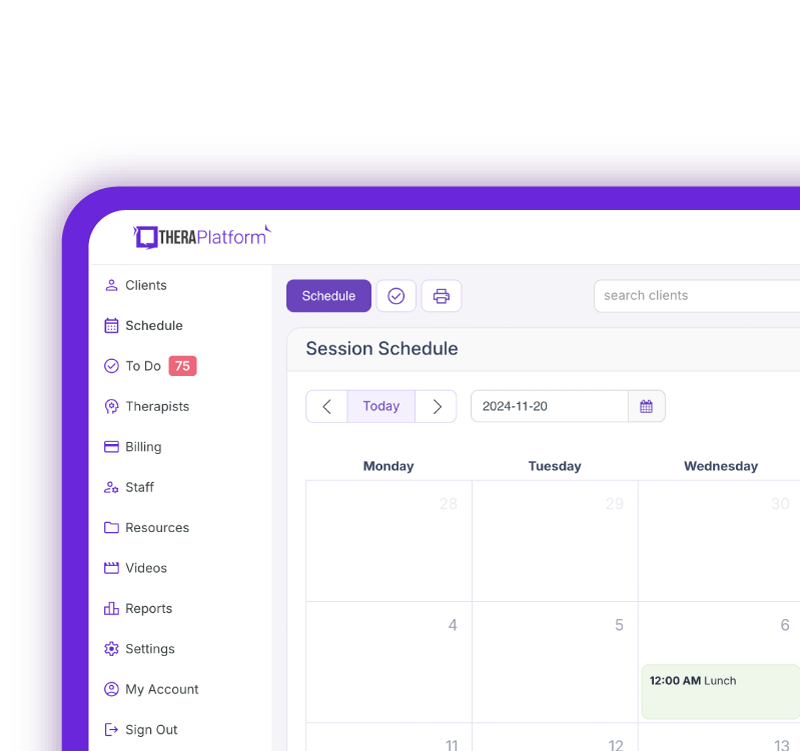Excludes 1

Excludes 1 is a part of the ICD-10 coding system and indicates mutually exclusive conditions that cannot be billed together. Excludes 1 in insurance billing means that two conditions cannot occur together, such as a congenital form versus an acquired form of the same condition. An exception to the Excludes 1 definition, however, is the circumstance when the two conditions are unrelated.
Summary
- Excludes 1 notes in ICD-10 indicate that two diagnoses are mutually exclusive and should not be billed together.
- Including two conflicting codes can lead to claim denials, delayed reimbursement, and increased documentation requirements. Enrolling in an insurance billing course for therapists can help providers enhance their knowledge.
- Therapists must understand and follow Excludes 1 guidelines to ensure accurate billing and avoid insurance errors.
- Using integrated EHR and billing software like TheraPlatform can help automate and streamline the claims process while supporting compliance.
→ Click here to enroll in our free on-demand Insurance Billing for Therapists video course [Enroll Now]
For therapists, it is important to understand the concept of excludes because if a therapist includes two mutually exclusive codes in a claim, the Excludes 1 note may result in a denial, as the insurance system will understand it as a coding error.
Excludes 2 notes indicate that the condition excluded is not part of the condition represented by the code, but a patient may have both conditions at the same time.
For therapists, understanding medical billing and coding guidelines including Excludes 1 is vital for accurate claims submissions and reimbursement.
Streamline your insurance billing with One EHR
- Claim batching
- Auto claims
- Automated EOB & ERA
- Real-time claim validation
- Real-time claim tracking
- Aging and other reports

Overview of ICD-10 coding system
The ICD-10 coding system is a global system for coding causes of mortality. The correct and accurate use of ICD-10 codes are required to justify the medical necessity of the services provided which impact reimbursement rates and claim outcomes.
When an Excludes 1 is present in diagnostic codes, it means that it cannot be coded with a primary diagnosis. It assists with claim submissions that align with clinical standards and prevents contradictory codes.
Excludes 1 is critical for avoiding claim denials to reduce coding errors, allows for consistency and accuracy in claims, supports documentation requirements, and helps to speed up reimbursement times.
Watch this video to learn common insurance billing struggles and solutions
→ Start My Free Trial
→ Start My Free Trial
Excludes 1 in Practice
For therapists, including occupational, physical, speech, and mental health therapists, it is critical to understand the concept of Excludes 1. These notes can prevent incorrect coding and help ensure efficient claim processing. Here are some examples of different therapy disciplines.
Occupational Therapists: General Motor Development Disorder vs Cerebral Palsy
- An occupational therapist working with a child with motor development development challenges may need to choose between codes of general motor development disorder (F82) and Cerebral Palsy (G80). These two conditions have an Excludes 1 note, which means they cannot be coded together. Motor development disorder is a general diagnosis and cerebral palsy is a specific diagnosis. If the therapist tries to include both, it may result in claim denials.
Physical Therapists: Fractures vs. Musculoskeletal conditions
- A physical therapist working with an individual with a fracture (S42) may also exhibit symptoms of musculoskeletal conditions such as arthritis. Coding for both of these conditions may lead to claims issues.
Speech Language Pathologists: Speech Sound Disorders vs. Developmental Delays
- Speech therapists working with a child with a Speech Sound disorder (F80.0) cannot code for Developmental Delay (F88) as well because they are two different issues, which can lead to claim denials.
Mental Health Therapists: Mood Disorders vs. Personality Disorders
- Major depressive disorder (ICD-10 code F32 or F33) and Persistent Depressive Disorder (ICD-10 code F34.1) have an Excludes 1 note because they are considered clinically distinct forms of depression. If a therapist bills for both codes, it may result in a denial, as this combination can be interpreted as a coding error.
Practice Management + EHR + Telehealth
Mange more in less time in your practice with TheraPlatform

.
How Excludes 1 affects insurance claims
In ICD-10 coding Excludes 1 notes are important for utilizing codes accurately and ensure compatibility with insurance requirements. If Excludes 1 notes are ignored, it can lead to claim denials, claim delays, and impact reimbursement time.
Therapists need to comply with ICD-10 guidelines, have coding training and resources for therapists, utilize EMRs that comply with Excludes 1 and ICD-10 guidelines, and meticulously document notes.
Furthermore, therapists need to utilize tools and resources such as the ICD-10 coding manuals, websites such as ICD-10 data, and CMS, and consult with coding specialists when unsure about diagnosis exclusions.
Excludes 1 FAQs for therapists
- Can I bill for two diagnoses if one has an Excludes 1 note?
- A therapist cannot bill for two diagnoses if one diagnosis has an Excludes 1 note. Excludes 1 notes indicate that the two conditions are mutually exclusive and should not be coded together because they represent conflicting or incompatible diagnoses.
- What should I do if the insurance company denies my claim based on Excludes 1?
- Review claim denial
- Check coding guidelines
- Revise and resubmit claim
- Are there exceptions to the Excludes 1 rule?
- Excludes 1 usually has a strict incompatibility with other diagnoses. However, in unique cases, detailed documentation and consulting with insurers may assist with certain coding combinations. It is always best to adhere to Excludes 1 guidelines.
Common challenges with Exclude 1
Common challenges related to Excludes 1 that therapists often encounter include:
- Increased claim denials
- Increased paperwork and documentation requirements
- Limited education on coding
It is imperative that therapists understand medical billing and coding in regards to Excludes 1, to optimize and increase efficiency in billing for reimbursement.
Excludes 1 notes are a critical component of ICD-10 coding which impacts billing and reimbursement. A fundamental understanding of Excludes 1 guidelines is essential for therapists to prevent claim denials, minimize delays, and ensure an efficient billing process.
Staying current with coding updates and utilizing available tools and resources can support therapists in efficiency, reimbursement, and compliance in their practice.
Practice Management + EHR + Telehealth
Mange more in less time in your practice with TheraPlatform

.
How EHR and practice management software can save you time with insurance billing for therapists
EHRs with integrated billing software and clearing houses, such as TheraPlatform, offer therapists significant advantages in creating an efficient insurance billing process. The key is minimizing the amount of time dedicated to developing, sending, and tracking medical claims through features such as automation and batching.
What are automation and batching?
- Automation refers to setting up software to perform tasks with limited human interaction.
- Batching or performing administrative tasks in blocks of time at once allows you to perform a task from a single entry point with less clicking.
Which billing and medical claim tasks can be automated and batched through billing software?
- Invoices: Create multiple invoices for multiple clients with a click or two of a button or set up auto-invoice creation, and the software will automatically create invoices for you at the preferred time. You can even have the system automatically send invoices to your clients.
- Credit card processing: Charge multiple clients with a click of a button or set up auto credit card billing, and the billing software will automatically charge the card (easier than swiping!)
- Email payment reminders: Never manually send another reminder email for payment again, or skip this altogether by enabling auto credit card charges.
- Automated claim creation and submission: Batch multiple claims with one button click or turn auto claim creation and submission on.
- Live claim validation: The system reviews each claim to catch any human errors before submission, saving you time and reducing rejected claims.
- Automated payment posting: Streamline posting procedures for paid medical claims with ERA. When insurance offers ERA, all their payments will post automatically on TheraPlatform's EHR.
- Tracking: Track payment and profits, including aging invoices, overdue invoices, transactions, billed services, service providers.
Utilizing billing software integrated with an EHR and practice management software can make storing and sharing billing and insurance easy and save providers time when it comes to insurance billing for therapists.
Streamline your practice with One EHR
- Scheduling
- Flexible notes
- Template library
- Billing & payments
- Insurance claims
- Client portal
- Telehealth
- E-fax

Resources
TheraPlatform is an all-in-one EHR, practice management, and teletherapy software built for therapists to help them save time on admin tasks. It offers a 30-day risk-free trial with no credit card required and supports mental and behavioral health, SLPs, OTs, and PTs in group and solo practices.
More resources
- Therapy resources and worksheets
- Therapy private practice courses
- Ultimate teletherapy ebook
- The Ultimate Insurance Billing Guide for Therapists
- The Ultimate Guide to Starting a Private Therapy Practice
- Mental health credentialing
- Insurance billing 101
- Practice management tools
- Behavioral health tools
Free video classes
- Free on-demand insurance billing for therapist course
- Free mini video lessons to enhance your private practice
- 9 Admin tasks to automate in your private practice
References
Centers for Disease Control and Prevention. ICD-10. Centers for Disease Control and Prevention. https://www.cdc.gov/nchs/icd/icd-10/index.html#:~:text=The%20International%20Classifi%20cation%20of%20Diseases,Health%20Organization%20publishes%20ICD%2D10.
ICD-10 CM Diagnosis Code Combinations (Excludes1).
ICD-10-CM guidelines April 1 2023 FY23.
Q&A: Clarifying Inclusion and Exclusion Notes. ACDIS. https://acdis.org/articles/qa-clarifying-inclusion-and-exclusion-notes#:~:text=%E2%80%9%20CA%20type%202%20Excludes%20note,conditions%20at%20the%20same%20time



